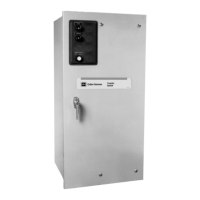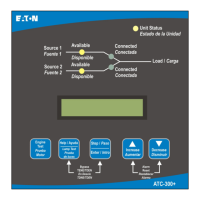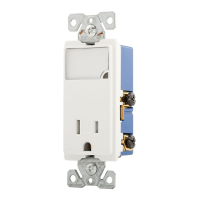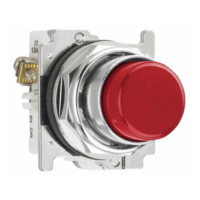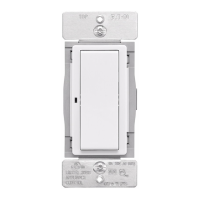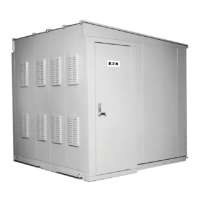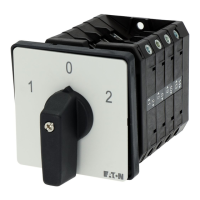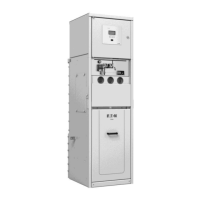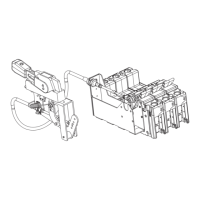For more information visit: www.eaton.com IB01602008E
Instructional Booklet
Page 32 Effective: March 2014
ATC-300 Breaker Based Transfer Switch
Step 3: With the emergency generator in the OFF position, close
the Source 2 power source upstream protective device,
assuming such a device used.
Step 4: Close any generator engine-start controls opened as a
result of actions taken in Step 4, Section 6.1.2.
Step 5: Where required, use an accurate voltmeter to check
phase-to-phase and phase-to-neutral voltages present at
the transfer switch Source 1, Source 2, and/or load termi-
nals.
6.1.4 Operational Checks
Step 1: Check to ensure that the Source 1 switching device is in
the CLOSED position. This should have been done in Sec-
tion 6.1.3, Step 1.
Step 2: Initiate an automatic transfer operation from the Source 1
to the Source 2 power source by pressing the <Engine
Test> pushbutton two times.
Note:The ATC-300 Logic Controller provides the capability to set the
Engine Test function to:
1. No Load Engine Test;
2. Load Engine Test; or
3. Disabled.
The factory default is set to:
1. Load Engine Test
a. After the Time Delay Engine Starting (TDES) has timed out,
the engine should start, run, and build up to normal voltage
and frequency.
b. The transfer switch will transfer to the Source 2 power
source (the Source 1 switching device opens and Source 2
switching device closes) after the Time Delay Normal to
Emergency (TDNE) times out.
Step 3: Initiate an automatic transfer operation back to the Source
1 power source by pressing the <Engine Test> pushbut-
ton one time.
1. After the Time Delay Emergency to Normal timer (TDEN)
has timed out, the transfer switch will transfer back to
the Source 1 power source (the Source 2 switching
device opens and the Source 1 switching device closes).
2. The Time Delay for Engine Cool-Off (TDEC - Feature 4)
will allow the engine to run unloaded for a preset time
after transfer to the Source 1 power source is com-
pleted.
6.1.5 Alternate Tests
1. Alternate operational tests may be possible depending upon
the options provided with any given ATS. Refer to the sche-
matic diagram provided with the ATS equipment, along with
the specification nameplate, to determine the exact options
provided.
2. If you attempt to manually operate the ATS with the Source 1
power source connected and available, the ATC-300 logic will
cycle the ATS back to the Source 1 power source since it is
the preferred source. The ATS was designed with this safety
feature in case a manual transfer is attempted while the
switch is in automatic mode and under load.
6.2 Problem Solving
HAZARDOUS VOLTAGES IN AND AROUND ATS EQUIPMENT DURING
THE PROBLEM SOLVING PROCESS CAN CAUSE SEVERE PERSONAL
INJURY AND/OR DEATH. AVOID CONTACT WITH ANY VOLTAGE
SOURCE WHILE PROBLEM SOLVING.
ONLY PROPERLY TRAINED PERSONNEL, FAMILIAR WITH THE ATS
EQUIPMENT AND ITS ASSOCIATED EQUIPMENT, SHOULD BE PERMIT-
TED TO PERFORM THE PROBLEM SOLVING FUNCTION. IF AN INDI-
VIDUAL IS NOT QUALIFIED TO PERFORM THE PROBLEM SOLVING
FUNCTION, THE INDIVIDUAL SHOULD NOT ATTEMPT ANY OF THESE
PROCEDURES.
A basic problem-solving effort is the first step to take prior to call-
ing for assistance. Frequently, the effort will successfully address
most problems encountered. The problem solving procedure is
presented in the Troubleshooting Guide (Table 3, Section 7 of
ATC-300 Controller Instruction Booklet IB01602009E). Remem-
ber, only qualified individuals familiar with the ATS equipment and
the system in which it is applied should attempt these problem
solving procedures.
If a problem persists after having completed the problem solving
procedure, contact a Eaton representative for further assistance.
When calling for assistance, the following is the minimum informa-
tion required to properly address the need:
1. Style number of ATS, if applicable;
2. Catalog number of ATS;
3. Actual location of the ATS (type of facility, address, etc.);
4. Company name and name and position of individual represent-
ing company;
5. Basic description of the situation as it exists; and
6. Any results of the problem solving steps taken and/or read-
ings taken.
NOTICE
AT THIS POINT, AND PRIOR TO MAKING ANY ATTEMPT TO ENER-
GIZE THE ATS EQUIPMENT, THE ENGINE-DRIVEN GENERATOR
SHOULD BE OPERATED. IF NECESSARY, THE VOLTAGE REGULA-
TOR ON THE GENERATOR SHOULD BE ADJUSTED ACCORDING TO
THE MANUFACTURER’S RECOMMENDATIONS. THE ATS EQUIP-
MENT WILL RESPOND ONLY TO THE RATED VOLTAGE AND FRE-
QUENCY PROGRAMMED INTO THE CONTROLLER.
WARNING
WARNING

